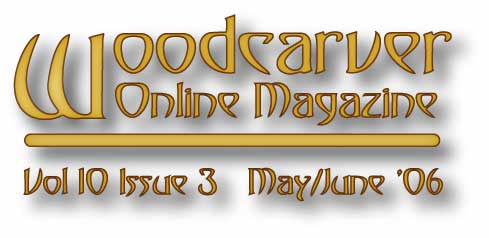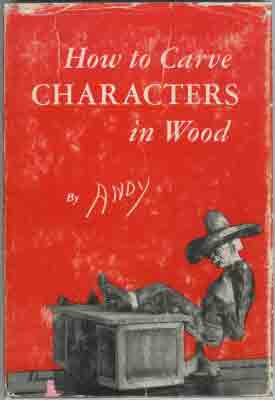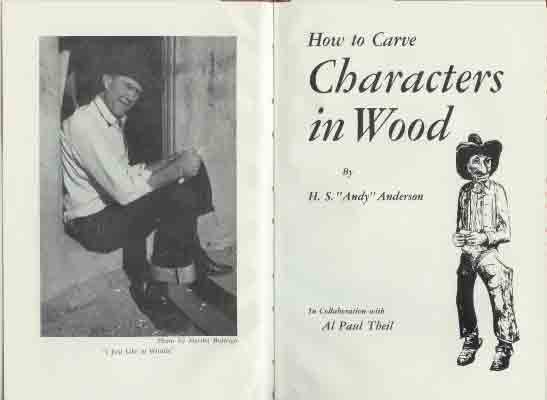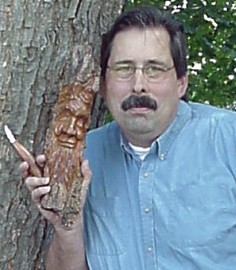

 Do
you know what someone called me the other day? They said
I was a "book horse". That's woodcarving book horse to you
buddy. There was no use denying it, and it explains a lot
about how I acquired this copy of How to Carve Characters
in Wood by Andy Anderson.
It would be impossible for a woodcarver, especially one of largely
Swedish ancestry who started figure carving in the "flat
plane" style, to progress very far and not hear of Andy Anderson.
For me, his name really came to the forefront when I read an article
on the cowboy woodcarver written by Harley Refsal in Woodcarving
Illustrated (Spring/Summer '99). The article painted
a wonderful portrait of Andy, quoted several times from his book,
and made a strong case for his original influence being the Swedish
figure carver Axel Peterson Doderhultarn. Mr. Refsal
had obviously done some careful research. Careful research
which included a tidbit of how Andy's book, How to Carve Characters
in Wood, was checked out of a U.S. military library based
in the Phillipines by a young soldier named Harold Enlow.
Now this was a book with
influence. The final straw was a cross reference to his
biography in the Scandinavian
flat-plane style section of Wikipedia... gotta have a copy
of that book.
Do
you know what someone called me the other day? They said
I was a "book horse". That's woodcarving book horse to you
buddy. There was no use denying it, and it explains a lot
about how I acquired this copy of How to Carve Characters
in Wood by Andy Anderson.
It would be impossible for a woodcarver, especially one of largely
Swedish ancestry who started figure carving in the "flat
plane" style, to progress very far and not hear of Andy Anderson.
For me, his name really came to the forefront when I read an article
on the cowboy woodcarver written by Harley Refsal in Woodcarving
Illustrated (Spring/Summer '99). The article painted
a wonderful portrait of Andy, quoted several times from his book,
and made a strong case for his original influence being the Swedish
figure carver Axel Peterson Doderhultarn. Mr. Refsal
had obviously done some careful research. Careful research
which included a tidbit of how Andy's book, How to Carve Characters
in Wood, was checked out of a U.S. military library based
in the Phillipines by a young soldier named Harold Enlow.
Now this was a book with
influence. The final straw was a cross reference to his
biography in the Scandinavian
flat-plane style section of Wikipedia... gotta have a copy
of that book.
After a little web research amongst the used
book sources I learned the original hardcover was published in
1953 and there was a softcopy reprint in 1972. I found copies
for sale, but...YIPES! $80 dollars in good condition?! My
woodcarving addiction is financially self sustaining, but not
that self sustaining.
I took a chance on a $37 "hardback" with a worn dust
jacket. While I was waiting for delivery I found myself
in Colorado Springs thanks to that pesky 8-5 "thang"
that pays the mortgage. Got a chance to check out "Hooked
on Books" on Academy Blvd. where there was a wonderful selection
of woodworking and woodcraft books (and SciFi, and Native American
reference, and...). I had several out-of-print woodcarving
books to choose from, but only come away with John Rood's Sculpture
in Wood with a dust jacket (my copy had none). While
I searched I tried to nail down why some books, while outdated
in several aspects, were still worthwhile while others were just
"old". You'll no doubt read about it here when
I figure it out, but at that time I was hoping Characters
in Wood had "the" quality. It was waiting
for me when I got home, and I was not disappointed.
The Highlights:
The book is surprisingly small physically (8"
x 5 1/4") and and a quick read (82 pages). Despite
it's diminutive size the book was a wonderful, picture window
view into the history of figure carving in the United States and
one of it's largest contributors. The author describes himself
very modestly and in a easily read style. The writing style
could, in part, be thanks to Al Paul Theil who Anderson collaborated
with for this book. The book's instructional value has faded
somewhat, but there are some gems still in those sections as well.
For example, in the "Poor Colors" chapter I had to translate
"colors ground in oil" to "artist oil colors"
(correctly, I hope), but his message that staining your carving
with colors was preferable to painting them came through five
by five. "Your colors will be soft, yet penetrating,
and you won't have a cheap gaudy look on your figures." ...And
where in the world would I find a hollow ground, straight razor
to make the knife described in the "Need Tools" chapter?
At almost any flea market or lesser antique shop, that's where.
Look for ones with broken handles or broken blades since you won't
use the handle and will be grinding down the blade anyway.
They will be worth less to collectors, and cheaper that way.


A brief tour:
Forward
Andy the Woodcarver
- Autobiography.
Wood Carving, an Old Art
- A very brief, but complete history of woodcarving, complete with a reference to Grinling Gibbons. There's only one serious omission, which I discuss in Nit Picks.
"How Does One Start?"
- Patience, practice, and carving beeswax. Make a mistake? Melt it down and carve it again.
You Can't Whittle and Carve Without Tools
- A short list of basic tools, and a description on making a carving knife from a straight razor.
You'll Need a Place to Whittle
- Small workshop area... not very big.
Patience Plus Practice
- A good re-occurring theme.
Don't Ruin a Good Job With Poor Colors
- Wow! Ground oil colors mixed with white gas.
The Wood Chain
- If you read between the lines, it sounds like he put this in only because he had so many requests for how to do it.
You'll Need Pattern
- ...and instructions on using them.
A Roundup
- "Don't get the idea or impression that you will be a crackerjack wood carver simply by reading this book."... again, practice and patience.
Nit Picks:
 Mike Bloomquist is a carver
and carving teacher, and a regular contributor to WOM.
Mike Bloomquist is a carver
and carving teacher, and a regular contributor to WOM.
You may visit Mike's web site, Wooden Dreams Woodcarving HERE or email him at m.bloomquistATverizonDOTnet.